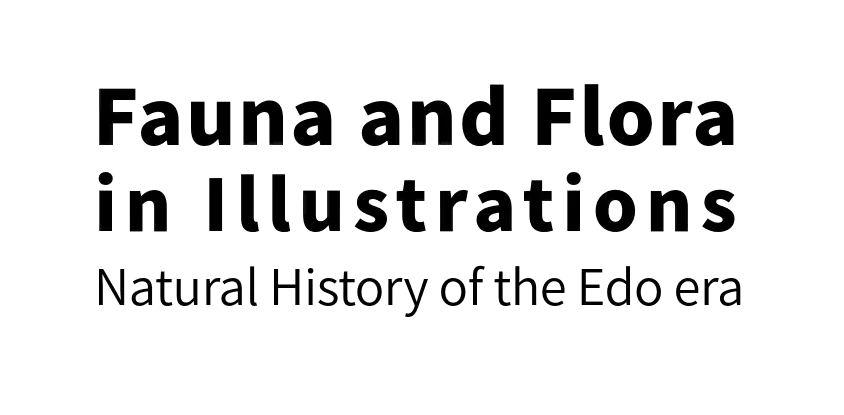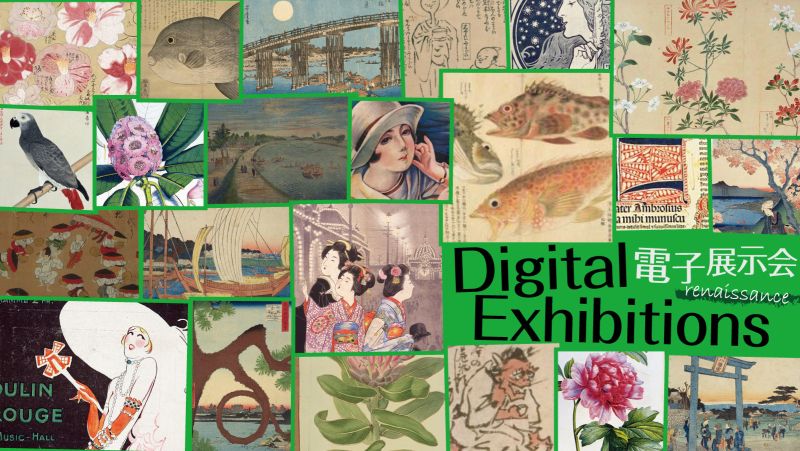
Chapter 1 Natural History during the Edo Period
The beginning of progress in the 17th century
Fauna and Flora in Illustrations: Natural History of the Edo era
1. The introduction of Honzo komoku and its influence during the 17th century
In 1596, Ming-era naturalist Li Shizhen (李時珍) borrowed from the existing writings of Chinese medical scholars to publish Bencao gangmu (本草綱目, later known in Japan as Honzo komoku). This book was introduced to Japan no later than 1604. Honzo komoku was superior to other natural history books in terms of its descriptions of the morphology of flora and fauna. For this reason, it had a significant impact on Japanese naturalists and copies were continuously imported from China. Honzo komoku was valued as a primary source book until the end of the Edo era and was published in large numbers as a wakokubon (和刻本, books transcribed from Chinese originals and printed in Japan).
『本草綱目』
Li Shizhen, ed., 1st ed., Jinling, 1590, vol. 1 of 27 <205-5>
The first edition was published in Jinling (金陵) (modern-day Nanjing), and thus became known as the Jinling Book. The picture below shows the names of authors whose works were included as well as of other persons involved in the book’s creation, and at the end of these pages is a note which indicates that the book was published in Jinling. This first edition is so rare that there are only seven complete copies extant today. Four of them are held by Japanese institutions: the National Diet Library, Toyo Bunko, Naikaku Bunko and Tohoku University Library Kano Collection.
本草綱目 第1冊
本草綱目 第1冊
『本草綱目』
Li Shizhen, ed., 1st ed., Jinling, 1590, vol. 2 of 27 <205-5>
These illustrations (Figure 1) from the first edition are said to have been drawn by Li’s son and appear to be too amateurish for this great work. They were later redrawn (Figure 2) for subsequent editions in China, and this revision was adopted for Japanese editions, as well.
本草綱目 第2冊
本草綱目
2. Japanese editions (wakokubon) of Honzo komoku
As the remarkable achievements of Honzo komoku were recognized, it was reprinted continuously in China and in Japan. Shown below are examples from six of the 14 extant wakokubon that form three distinct genealogical lines.
本草綱目53卷瀕湖脈學1卷奇經八脈攷1卷 [13]
本草綱目52卷瀕湖脈學1卷奇經八脈攷1卷脈訣攷證1卷 [27]
本草綱目52卷圖1卷附結髮居別集4卷本草圖4卷 [7]
本草綱目52卷圖3卷脈學1卷奇經八脈1卷 [26]
本草綱目卷1-21,39-52圖卷上中瀕湖脉學1卷奇經八脉攷1卷脉訣攷證1卷附本艸綱目品目1卷本草名物附録1卷 [10]
本草綱目52卷圖3卷瀕湖脉學1卷奇經八脉攷1卷脉訣攷證1卷
Figure 1. 1637, vol. 15 of 36 volumes <特1-3024>
This is the first wakokubon of Honzo Komoku, and the printing blocks from this edition were also used for numerous others, including those of Figure 2 and Figure 3 below.
Figure 2. A later imprint made with the printing blocks from Figure 1, vol. 27 of 36 volumes <特1-862>
The text is an imprint of the same printing blocks used for Figure 1, but the illustrations are based on those of a later Chinese version. This edition combines content taken from several other editions published as late as 1653.
Figure 3. 1714, newly corrected by INO Jakusui, vol. 8 of 41 volumes, <特1-970>
As with Figure 2, the text is an imprint of the same printing blocks used for Figure 1. This edition incorporates corrections made by INO Jakusui, who was the most famous naturalist of the day and is considered the best of the many wakokubon of Honzo komoku.
Figure 4. 1669, corrected by MATSUSHITA Kenrin, vols 39 and 40 of 38 volumes <特1-895>
An imprint of printing blocks that were engraved in 1659. This edition is called Tenji-bon (Tenji book), because the title is written in the tenji (篆字) style of Chinese characters.
Figure 5. A later imprint of an edition published in 1672, kaibara-bon (貝原本), vol. 8 of 28 volumes <特1-969>
This version is known as the Kaibara-bon (Kaibara book, 貝原本), because its appendix attributes its annotations to KAIBARA Ekiken (貝原益軒), a famous, Edo-period naturalist. Although the annotation indicates that this is a corrected version, the year of publication is unknown.
Figure 6. A later imprint of an edition published in 1672, kaibara-bon, vol. 52 in 39 volumes <157-42>
This edition is an imprint of the printing blocks used to publish Figure 5, but the year of publication is unknown.
3. First steps in a distinct direction
As Edo-period publishers began to thrive, encyclopedic works began to appear in the latter 17th century, followed by books for non-specialists on subjects such as horticulture or collecting shells. Also at this time, books such as Yamato honzo (大和本草), which did not blindly follow the content of Bencao gangmu, were published.
Somoku shasei shunju no maki
KANO Shigekata, illus., 1657–1699, manuscript vol. 春下 of 4 <寄別10-39>
The gillyflower shown on the right of the page comes from the Mediterranean region and was first brought into Japan during the early Edo era. This illustration was drawn in 1660 and is the first known documentation in Japan of the name and morphology of this flower. To the left is a plant called shungiku (春菊, glebionis coronaria), but it is not the same species that is known by that name today. The details of painter KANO Shigekata’s career are not clear, but he seems to have had some connection to the Kano region of modern-day Gifu Prefecture. This book contains a total of 284 species, most of which are horticultural vegetation, with illustrations made between 1657 and 1699.
Kadan komoku
Figure 1. MIZUNO Motokatsu, 1664, copied by SHIRAI Kotaro in 1924 <特1-45>
Figure 2. MIZUNO Motokatsu, 1681 <特1-1782>
Kadan Komoku is the first comprehensive book on horticulture and includes no illustrations. Of the species included in the manuscript (Figure 1, left), only six appear in the printed edition (Figure 2, right). The manuscript contains notes on other names, color of flowers, and cloning season, to which the printed edition adds information on soil properties and suitable fertilizers but still lacks descriptions of morphology. The printed edition describes 192 types of plants, including notable numbers of species of chrysanthemum, camellia, and azalea.
花壇綱目(稿本)
花壇綱目(刊本)
Kinmo zui
NAKAMURA Tekisai, ed., 1666, 1st ed., vol. 20 of 14 <117-18>
This is the first encyclopedia published in Japan and includes 668 illustrations of flora and fauna, most of which are depicted realistically and which comprise 45% of all the illustrations in the book. Impatiens and narcissus are shown on the right of the page, while aibika and gillyflower are on the left. All of these were introduced to Japan between the Muromachi and early-Edo eras.
Gengzhi tu
Figure 1. Lou Shou, illus., KANO Eino, ed., 1676, vol. 1 of 2 <W488-12>
Figure 2. Jiao Bingzhen, illus., published during the Qing era, vol. 1 of 2 <特1-2481>
Gengzhi tu, by Song dynasty painter Lou Shou (1090–1162), illustrates scenes of rice cultivation and sericulture and was dedicated to Emperor Gaozong. This work was first published in China in 1462 during the Ming era, and Figure 1 shows a printed edition that was copied from the original publication by KANO Eino in 1676. Kano’s work is considered to convey the spirit of the original version quite well. Figure 2 is from a different genealogic line, which was newly illustrated by order of Emperor Kangxi of the Qing dynasty. Shown here is the illustration “Cultivation by Buffalo” from each version.
耕織図 上
耕織図
六々貝合和歌
Kazuki no Amanoko, ed., 1690 <W89-60>
Collecting shells became a popular hobby during the 18th century, but even before then, kasengai (歌仙貝)—collections of 36 shells associated with waka poetry—were in fashion. The left figure shows some of the waka poetry, while The right figure shows illustrations of the associated shells.
貝茂塩草
WATABE Chikara, ed., 1741 manuscript <特1-2535>
According to an annotation in the right margin of this page, these illustrations were copied from other books published before Rokuroku kaiawase waka. Kai moshiogusa, one of the oldest books on shellfish, was used as a reference in compiling several other books on kasengai, but is not known well because few copies have survived.
大和本草
KAIBARA Ekiken, 1709, vol. 1 of 10 <特1-2292>
KAIBARA Ekiken was well known as a Confucian scholar and author of books on flora and fauna. In Yamato honzo, he broke away from the tradition of following Honzo komoku uncritically and developed a unique classification system specifically for plants and animals indigenous to Japan. The page shown here is part of the introduction, in which the author discusses existing natural history books. His criticism of Honzo komoku is indicated with arrows. This book was a primary source material for studying natural history during the Edo era.

